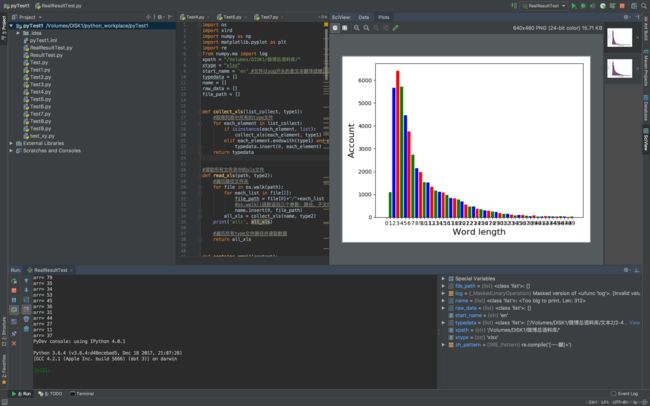import os
import xlrd
import numpy as np
import matplotlib.pyplot as plt
import re
from numpy.ma import log
xpath = "/Volumes/DISK1/微博总语料库/"
xtype = "xlsx"
start_name = 'yug'
typedata = []
name = []
raw_data = []
file_path = []
def collect_xls(list_collect, type1):
#取得列表中所有的type文件
for each_element in list_collect:
if isinstance(each_element, list):
collect_xls(each_element, type1)
elif each_element.endswith(type1) and each_element not in typedata and each_element.split('/')[-1].startswith(start_name):
typedata.insert(0, each_element)
return typedata
#读取所有文件夹中的xls文件
def read_xls(path, type2):
#遍历路径文件夹
for file in os.walk(path):
for each_list in file[2]:
file_path = file[0]+"/"+each_list
#os.walk()函数返回三个参数:路径,子文件夹,路径下的文件,利用字符串拼接file[0]和file[2]得到文件的路径
name.insert(0, file_path)
all_xls = collect_xls(name, type2)
print('all:', all_xls)
#遍历所有type文件路径并读取数据
return all_xls
def contains_emoji(content):
if not content:
return False
if u"\U0001F600" <= content and content <= u"\U0001F64F":
return True
elif u"\U0001F300" <= content and content <= u"\U0001F5FF":
return True
elif u"\U0001F680" <= content and content <= u"\U0001F6FF":
return True
elif u"\U0001F1E0" <= content and content <= u"\U0001F1FF":
return True
else:
return False
zh_pattern = re.compile(u'[\u4e00-\u9fa5]+')
def contain_zh(word):
word = word.encode().decode()
global zh_pattern
match = zh_pattern.search(word)
return match
def cutLongNameFun(s):
'''
longWords变为 long word:log里面有很多长函数名,比如WbxMeeting_VerifyMeetingIsExist。
将其拆成小单词wbx meeting verify meeting is exist,更有意义。若有大写则分割。
'''
# Build a cost dictionary, assuming Zipf's law and cost = -math.log(probability).
# 建立一个成本字典,假设Zipf定律和成本= -math.log(概率)。
words = open("/Users/chenqiuchang/Downloads/words-by-frequency.txt").read().split() # 有特殊字符的话直接在其中添加
wordcost = dict((k, log((i+1)*log(len(words)))) for i,k in enumerate(words))
maxword = max(len(x) for x in words)
def infer_spaces(s):
'''Uses dynamic programming to infer the location of spaces in a string without spaces.
.使用动态编程来推断不带空格的字符串中空格的位置。'''
# Find the best match for the i first characters, assuming cost has
# been built for the i-1 first characters.
# Returns a pair (match_cost, match_length).
def best_match(i):
candidates = enumerate(reversed(cost[max(0, i-maxword):i]))
return min((c + wordcost.get(s[i-k-1:i], 9e999), k+1) for k,c in candidates)
# Build the cost array.
cost = [0]
for i in range(1,len(s)+1):
c, k = best_match(i)
cost.append(c)
# Backtrack to recover the minimal-cost string.
out = []
i = len(s)
while i > 0:
c, k = best_match(i)
assert c == cost[i]
out.append(s[i-k:i])
i -= k
return " ".join(reversed(out))
print("==============", infer_spaces(s))
return infer_spaces(s)
def main():
all_xls = read_xls(xpath, xtype)
print('all_xls:', all_xls)
print("Victory")
arr = np.zeros((50), dtype=np.int)
print('空数组:', arr)
all_len = 0
large_len_arr = []
zh_arr = []
eg_arr = []
after_split_arr = []
cnt = 0
# 获取文档对象
for name_i in all_xls:
print('name:', name_i)
data = xlrd.open_workbook(name_i)
table = data.sheets()[0]
cols = table.col_values(2)
# 输出段落编号及段落内容
for i in range(len(cols)):
cnt += 1
print("第" + str(i) + "段的内容是:" + cols[i])
res = re.findall(r"[\w’]+", cols[i])
print('分隔特殊符号:', res)
temp = []
for j in res:
if not contain_zh(j) and not contains_emoji(j) and not re.compile('[0-9]+').findall(j):
temp.insert(0, j)
elif len(j) >= 30 and not contain_zh(j) and not contains_emoji(j) and not re.compile('[0-9]+').findall(j):
temp.insert(0, cutLongNameFun(j.lower()).split(" "))
print('处理后的temp:', temp)
if len(temp) >= 50:
large_len_arr.insert(0, cols[i])
continue
if len(temp) > 0:
arr[len(temp)] += 1
print('总共查找:', cnt, '个句子')
#print('包含中文的单词有:', zh_arr)
#print('去掉中文之后的字符串:', eg_arr)
print('长度超过50的句子有:', len(large_len_arr), "句\n==>", large_len_arr)
for key in range(50):
print('arr=', arr[key])
name_list = [1] * 50
for i in range(50):
name_list[i] = i
num_list = arr
plt.bar(range(len(num_list)), num_list, color='rgb', tick_label=name_list)
#plt.grid(True)
plt.xlabel('Word length', fontsize=16)
plt.ylabel('Account', fontsize=16)
plt.show()
return
if __name__ == "__main__":
main()
维语的统计结果:

英语的统计结果:


